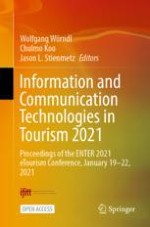1 Introduction
2 Theoretical Background
2.1 Perceived Risk and Travel Intention
2.2 Argument Quality and Source Credibility
2.3 Self-efficacy
3 Methodology
3.1 Measurement
3.2 Data Collection
Characteristics | Sapporo (N = 542) April 2020 | Wuhan (N = 516) March 2020 | Wuhan (N = 400) August 2020 | ||||
|---|---|---|---|---|---|---|---|
Frequency | % | Frequency | % | Frequency | % | ||
Gender | Male | 270 | 49.8 | 260 | 50.4 | 141 | 35.3 |
Female | 272 | 50.2 | 256 | 49.6 | 259 | 64.8 | |
Age | Below 20 | – | – | 12 | 2.3 | 50 | 12.5 |
20–29 | 105 | 19.4 | 141 | 27.3 | 225 | 56.3 | |
30–39 | 113 | 20.8 | 147 | 28.5 | 124 | 31.0 | |
40–49 | 104 | 19.2 | 153 | 29.7 | 1 | .3 | |
50 and above | 220 | 40.6 | 63 | 12.2 | – | – | |
Education | High school or below | 176 | 32.5 | 74 | 14.3 | 20 | 5.0 |
College | 150 | 27.7 | 108 | 20.9 | 44 | 11.0 | |
Bachelor’s degree | 195 | 36.0 | 278 | 53.9 | 270 | 67.5 | |
Master’s degree/PhD | 21 | 3.9 | 56 | 10.9 | 66 | 16.5 | |
4 Data Analysis
4.1 Exploratory Factor Analysis
Items | Sapporo (Apr 2020) | Wuhan (Mar 2020) | Wuhan (Aug 2020) | |||
|---|---|---|---|---|---|---|
Loading | Cronbach’s α | Loading | Cronbach’s α | Loading | Cronbach’s α | |
Argument quality | .802 | .815 | .721 | |||
AQ1. Information I received about COVID-19 is accurate | .592 | .524 | .542 | |||
AQ2. Information I received about COVID-19 is relevant to my need | .340 | – | .296 | |||
AQ3. Information I received about COVID-19 is comprehensive | .569 | .843 | .761 | |||
AQ4. Information I received about COVID-19 is up-to-date | .692 | .608 | .533 | |||
AQ5. Arguments of the information I received about COVID-19 are convincing | – | .734 | .645 | |||
Source credibility | .944 | .881 | .840 | |||
SC1. People providing information about COVID-19 are knowledgeable on the topic | .715 | .627 | .502 | |||
SC2. People providing information about COVID-19 have experience dealing with infectious diseases | .783 | .693 | .503 | |||
SC3. People providing information about COVID-19 are trustworthy | 1.025 | .914 | .876 | |||
SC4. People providing information about COVID-19 are reliable | .964 | .940 | .797 | |||
SC5. People providing information about COVID-19 are professional | .832 | – | .752 | |||
Self-efficacy | .902 | .785 | .719 | |||
SE1. I have confidence in my ability to search on COVID-19 related information | .755 | .788 | .471 | |||
SE2. I have confidence in my ability to understand COVID-19 related information | .900 | .764 | .758 | |||
SE3. I have confidence in my ability to evaluate the credibility of COVID-19 related information | .962 | .582 | .346 | |||
Risk perception | .846 | .750 | .623 | |||
PC1. COVID-19 is a frightening disease | .891 | .848 | .742 | |||
PC2. I am afraid of contracting COVID19 | .837 | .709 | .558 | |||
PC3. Compared to SARS and Avian Influenza, COVID-19 is more dangerous | .735 | .597 | .499 | |||
PC4. It is dangerous to travel because of COVID-19 | – | – | .407 | |||
Travel intention (Sapporo) | .909 | |||||
TIS1. I intend to visit Wuhan in the next 12 months | .841 | – | – | |||
TIS2. I intend to visit China in the next 12 months | 1.001 | – | – | |||
Travel intention (Wuhan) | .892 | |||||
TIW1. I intend to travel in the near future | – | – | .845 | |||
TIW2. I am planning to travel in the near future | – | – | .852 | |||
TIW3. I will make an effort to travel in the near future | – | – | .806 | |||
TIW4. I will certainly invest time and money to travel in the near future | – | – | .795 | |||
4.2 Hypothesis Testing
Hypotheses | Sapporo (Apr 2020) | Wuhan (Mar 2020) | Wuhan (Aug 2020) | |||
|---|---|---|---|---|---|---|
Standardized β | Result | Standardized β | Result | Standardized β | Result | |
H1. Perceived Risk → Travel Intention | −.205*** | Supported | – | – | .006 | Rejected |
H2. Argument Quality → Perceived Risk | .458*** | Supported | .100 | Rejected | .193** | Supported |
H3. Source Credibility → Perceived Risk | −.115* | Supported | −.081 | Rejected | .136* | Partly Supported |
H4. Self-Efficacy → Argument Quality | .304*** | Supported | .619*** | Supported | .538*** | Supported |
H5. Self-Efficacy → Source Credibility | .285*** | Supported | .419*** | Supported | .454*** | Supported |
